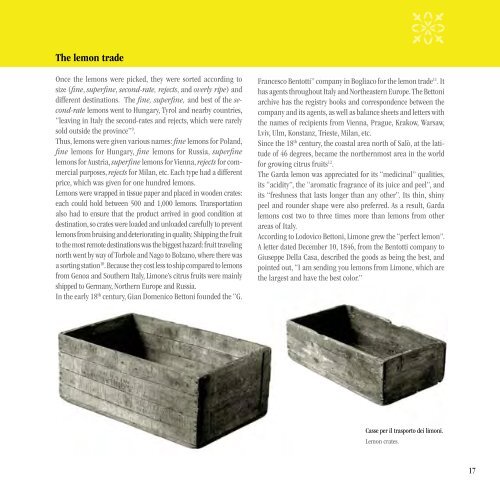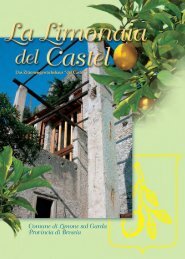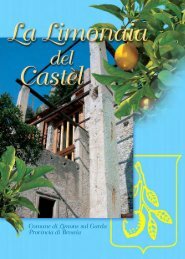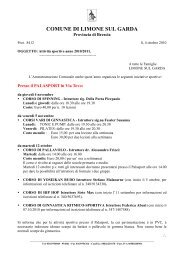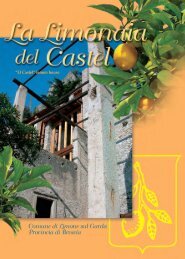Tra le limonaie di Limone sul Garda un percorso tra storia e cultura ...
Tra le limonaie di Limone sul Garda un percorso tra storia e cultura ...
Tra le limonaie di Limone sul Garda un percorso tra storia e cultura ...
- No tags were found...
Create successful ePaper yourself
Turn your PDF publications into a flip-book with our unique Google optimized e-Paper software.
The <strong>le</strong>mon <strong>tra</strong>deOnce the <strong>le</strong>mons were picked, they were sorted accor<strong>di</strong>ng tosize (fine, superfine, second-rate, rejects, and overly ripe) and<strong>di</strong>fferent destinations. The fine, superfine, and best of the second-rate<strong>le</strong>mons went to H<strong>un</strong>gary, Tyrol and nearby co<strong>un</strong>tries,“<strong>le</strong>aving in Italy the second-rates and rejects, which were rarelysold outside the province” 9 .Thus, <strong>le</strong>mons were given various names: fine <strong>le</strong>mons for Poland,fine <strong>le</strong>mons for H<strong>un</strong>gary, fine <strong>le</strong>mons for Russia, superfine<strong>le</strong>mons for Austria, superfine <strong>le</strong>mons for Vienna, rejects for commercialpurposes, rejects for Milan, etc. Each type had a <strong>di</strong>fferentprice, which was given for one h<strong>un</strong>dred <strong>le</strong>mons.Lemons were wrapped in tissue paper and placed in wooden crates:each could hold between 500 and 1,000 <strong>le</strong>mons. <strong>Tra</strong>nsportationalso had to ensure that the product arrived in good con<strong>di</strong>tion atdestination, so crates were loaded and <strong>un</strong>loaded carefully to prevent<strong>le</strong>mons from bruising and deteriorating in quality. Shipping the fruitto the most remote destinations was the biggest hazard: fruit <strong>tra</strong>velingnorth went by way of Torbo<strong>le</strong> and Nago to Bolzano, where there wasa sorting station 10 . Because they cost <strong>le</strong>ss to ship compared to <strong>le</strong>monsfrom Genoa and Southern Italy, <strong>Limone</strong>’s citrus fruits were mainlyshipped to Germany, Northern Europe and Russia.In the early 18 th century, Gian Domenico Bettoni fo<strong>un</strong>ded the “G.Francesco Bentotti” company in Bogliaco for the <strong>le</strong>mon <strong>tra</strong>de 11 . Ithas agents throughout Italy and Northeastern Europe. The Bettoniarchive has the registry books and correspondence between thecompany and its agents, as well as balance sheets and <strong>le</strong>tters withthe names of recipients from Vienna, Prague, Krakow, Warsaw,Lviv, Ulm, Konstanz, Trieste, Milan, etc.Since the 18 th century, the coastal area north of Salò, at the latitudeof 46 degrees, became the northernmost area in the worldfor growing citrus fruits 12 .The <strong>Garda</strong> <strong>le</strong>mon was appreciated for its “me<strong>di</strong>cinal” qualities,its “aci<strong>di</strong>ty”, the “aromatic fragrance of its juice and peel”, an<strong>di</strong>ts “freshness that lasts longer than any other”. Its thin, shinypeel and ro<strong>un</strong>der shape were also preferred. As a re<strong>sul</strong>t, <strong>Garda</strong><strong>le</strong>mons cost two to three times more than <strong>le</strong>mons from otherareas of Italy.Accor<strong>di</strong>ng to Lodovico Bettoni, <strong>Limone</strong> grew the “perfect <strong>le</strong>mon”.A <strong>le</strong>tter dated December 10, 1846, from the Bentotti company toGiuseppe Della Casa, described the goods as being the best, andpointed out, “I am sen<strong>di</strong>ng you <strong>le</strong>mons from <strong>Limone</strong>, which arethe largest and have the best color.”Casse per il <strong>tra</strong>sporto dei limoni.Lemon crates.17


